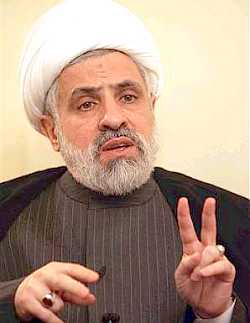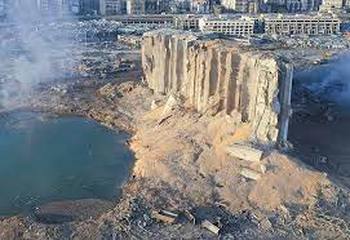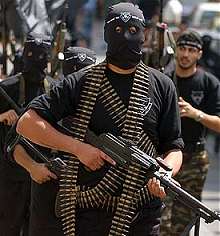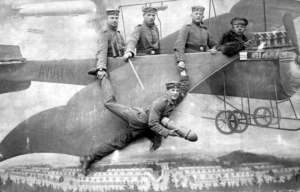Direct Translation via Google Translate. Edited.
by Artemy Sharapov
[REGNUM] Against the backdrop of military defeats and the protracted domestic political crisis they caused (which has once again worsened since mid-June), the Armenian government has made accusations against Russia.

In early July, the republic's Foreign Ministry handed a note of protest to the Russian ambassador over "unfriendly statements" on Russian TV channels and "attacks on the activities of the Armenian authorities." The authorities, led by Prime Minister Nikol Pashinyan, blame Moscow for their own miscalculations, consistently "breaking down" the relations that have developed over the past 500 years.
Over the years, both nations have fought shoulder to shoulder many times and together built a common future in a single country. However, it seems that Yerevan wants to cross out all the chapters of centuries-old friendship for the sake of its political ambitions.
Although in the past Russia, which has historically been friendly towards the Armenian people, has come to their aid more than once.
The history of Russian-Armenian relations can be counted from the moment of the emergence of Rus as a state, if not earlier. Armenian merchants actively participated in trade on the route "from the Varangians to the Greeks", along which the ancient Russian state was formed.
According to experts on the Middle Ages, an Armenian colony existed in Kiev as early as the 12th century. The campaign against the Seljuk Turks by the Georgian-Armenian army under the command of the Novgorod prince Yuri Andreevich, the son of Andrei Bogolyubsky and the husband and co-ruler of Queen Tamara, dates back to the same era (1185).
Armenian traders and artisans settled in Moscow as early as the 14th century. During the reign of Ivan the Terrible, an Armenian church operated in the capital of the Russian kingdom - dogmatic differences between the Orthodox and Armenian Apostolic churches did not interfere with mutually beneficial contacts.
It is believed that in memory of the Armenian soldiers who took part in the capture of Kazan, Tsar Ivan the Terrible dedicated one of the side chapels of the Pokrovsky Cathedral to Saint Gregory, the enlightener of Armenia.
Moreover, in Rus' there was already working, as they would say now, a creative intelligentsia of Armenian origin.
The court painter, the author of parsunas (portraits) of Tsar Alexei Mikhailovich was the artist Astvatsatur Saltanyan, who was called Bogdan Saltanov in Russian documents - a native of the diaspora, from the Persian city of Isfahan. Incidentally, the artist arrived in Moscow under the patronage of the influential Armenian merchant Zakhar Sagradov (Sarajyan), who was also the ambassador of the Persian Shah Abbas II at the Russian court.
By that time, the historical territory of Armenia had long been divided between two powerful and constantly warring powers - Persia and the Ottoman Empire, in whose rivalry the Armenians often found themselves on the losing end.
AN ANCIENT COUNTRY BETWEEN TWO FIRES
The history of Armenian statehood, which is usually dated from the 4th century BC, has known brilliant eras. For example, during the reign of Tigran II the Great (1st century BC – 1st century AD), the state with conquered lands stretched from the Mediterranean to the Caspian Sea. But this history was not continuous. Armenian lands were repeatedly divided between large neighbors: the Roman Empire and Persia, Byzantium and the Arab Caliphate, the Seljuks, the Mongols, and the Timurids.
In the mid-16th century, after yet another war, the Ottoman Sultan and the Persian Shah (Iran was then ruled by the Turkic Safavid dynasty) divided Armenia roughly along the line of the modern Turkish-Armenian border. The Western part went to the Turks, the Eastern part - with Erivan (Yerevan) - to the Persians.
In Sunni Turkey and Shiite Iran, the position of Christian Armenians was ambivalent. On the one hand, Armenian merchants grew rich from trade with Europe and Russia and carried out diplomatic missions. On the other hand, the “infidel” people were always in the position of second-class subjects, and this was not only due to the jizya, the tax that was collected from the “infidels.”
In 1604, Shah Abbas I carried out a real ethnic cleansing, which remained in the memory of the Armenian people under the name Surgun ("Exile"): about 350 thousand Armenians were expelled from their native places. Cities and villages were plundered. The Shah ordered the resettlement of non-believers deep into Persia, but many of those deported died or were killed along the way.
In Turkey, Armenian peasants were “only” oppressed by unbearable taxes, but during the wars with Iran, the border residents suffered first - and not only from the Sultan’s and Shah’s troops, but also from the Kurdish nomads.
The Armenian nobility (and up until the 18th century, Christian princes - meliks, vassals of the Persian shah, still retained power in small holdings in Nagorno-Karabakh) sought patronage from co-religionists, primarily from the Russian tsars.
The clergy of the Apostolic Church played a special role. But both under the last Rurikovichs and under Boris Godunov, the Russian kingdom, lacking resources for a military campaign in Transcaucasia, limited itself to political and financial support. With the Time of Troubles (coinciding with the Great Surgun), the Caucasian direction was temporarily forgotten.
ALIVE THANKS TO GOD AND THE TSAR
During the reign of the first tsars of the Romanov dynasty, Armenians increasingly began to turn to Russia for help. Several letters are known to have been sent by Armenian merchants to Tsar Alexei Mikhailovich, asking for permission to sell silk to Europe through Russian territory. Under Peter the Great, the volume of trade with Armenian merchants was constantly growing, so that the tsar in his decree to the Governing Senate specifically noted: "To increase Persian trade, and to favor the Armenians as much as possible and facilitate them in whatever is appropriate, so as to encourage them to come more often."
On the other hand, in 1725, shortly before the death of Emperor Peter the Great, a petition from the Karabakh meliks and Catholicoses Yesai and Nerses arrived in St. Petersburg :
"Your Imperial Majesty!.. We are surrounded by merciless enemies: Persians, Ottoman Turks, Dagestanis and others. We are still fighting them, fighting back, but we have remained alive thanks to the fact that we have God above us, and on earth - you, Your pious and God-loving Majesty - our hope and support. We beg you, great Sovereign, to come to our aid."
At the moment the message was sent, the Turks invaded Transcaucasia; Yerevan and the Armenian communities of Tiflis and Nakhichevan again experienced the cruelty of the conquerors.
David-bek and Mkhitar Sparapet, who raised an uprising in Eastern Armenia in 1722–28, counted on the help of the Russian Tsar. By that time, Russia's advance in Transcaucasia had not yet reached Armenia, but our country accepted Christian refugees within its borders - for example, under Catherine II, the city of Nor-Nakhichevan (New Nakhichevan), now a district of Rostov-on-Don, arose on the banks of the Don.
WHY GRIBOYEDOV DIED
Changes in the situation of at least the eastern part of the Armenian people occurred after the Russo-Persian Wars of 1804-1813 and 1826-1828 and the Russo-Turkish War (1828-1829), won by Russia. The merit of liberating Yerevan from the Persian yoke belongs to the hero of the war of 1812 and the Foreign Campaign, participant in the capture of Paris Ivan Paskevich. For the capture of Yerevan, the general was awarded the title of count and the addition of Paskevich-Erivansky to his surname.
The transition of the Christians of Eastern Armenia under the protection of the co-religious Russia was secured by the Treaty of Turkmanchay in 1828 with the defeated Persia. According to Chapter XV of this treaty, the descendants of the Armenians driven into Persia had the right to free repatriation to the Russian Empire. Russia also insisted on the liberation of Armenian slaves.
By the way, the imperial ambassador to Tehran, Alexander Griboyedov, monitored compliance with the terms of the agreement; he also compiled reports for Paskevich on the progress of the repatriation of Armenians from Aderbeijan (Iranian Southern Azerbaijan) to the new Russian lands, noting that “those who came from Persia were mostly artisans and farmers” and, therefore, could be of great benefit in their historical homeland.
And it was precisely the fact that the poet and diplomat was hiding Georgians and Armenians on the mission's territory that became one of the reasons for the attack on the embassy, in which Griboyedov died. By "hushing up" the incident, fraught with a new war, the Shah's government demonstrated its readiness to observe the Turkmanchay Peace Treaty - from 40 to 90 thousand Armenians moved to Russia.
According to the terms of the Treaty of Adrianople in 1829, up to 100 thousand more people moved from the Ottoman Empire to Russia, populating the territories of modern Georgia, Armenia, and also the present-day Krasnodar Krai and Stavropol Krai. Throughout the 19th century, our consuls in Istanbul and Tehran played the role of defenders of the rights of the local Christian population, including Armenians. Armenians persecuted for religious and political reasons found refuge behind the fence of diplomatic missions.
THE GREAT CRIME
At the beginning of the 20th century, nationalist movements began to gain strength all over the world. The Ottoman Empire was no exception, where, on the one hand, Turkish nationalism (which took the form of the Young Turk movement) was gaining strength, and on the other hand, both Arab-Muslim and Christian (Armenians, Greeks, Assyrians) subjects of the Sultan began to demand respect for their rights.
The Armenians perceived the First World War as a hope for deliverance, but it brought the greatest tragedy in the history of the ancient people. With the outbreak of the war, the Young Turk triumvirate ( Enver Pasha, Talaat Pasha and Djemal Pasha ), which controlled the Sultan's government, began to requisition the property of Christians. At the instigation of the triumvirate, Sultan Mehmed VI, who also bore the title of Caliph of the Faithful, declared jihad - which became the pretext for attacks on Christians.
Volunteer Armenian squads from all over the world joined the Russian army. The "Turkish" Armenians, suffering from Ottoman oppression, often greeted the troops of the Caucasian Front as liberators, supporting them. In response, the Sultan's government accused the Armenians of high treason and betrayal.
Since April 1915, the deportation of Armenians from Western Armenia, Anatolia and Cilicia began, accompanied by mass murders of the civilian population. In Armenian history, these events became known as "Meds Yeghern" - "The Great Crime", and in European and Russian historiography as the genocide of the people of Ottoman Armenia. The history of the Genocide is a topic for a separate discussion, we will only note that at the hands of soldiers of the Sultan's army and the Kurdish irregular militia, as well as during the "death marches", at least 1.5 million Armenians died.
The Armenian militias fought back against the Turks – the heroic defense of the city of Van in April–May 1915 went down in history, but without Russia’s help the resistance would have been doomed.
Western historians pay less attention to the fact that with the advance of the Caucasian Front in 1916, between 350,000 and 400,000 Armenians found refuge in the territory occupied by Russian troops and in the Russian Empire itself. Many Armenian historians believe that thanks to Emperor Nicholas II's decision to open the border to accept refugees, the Armenian nation was saved from complete annihilation.
The plans for the post-war reconstruction of the Ottoman Empire assumed the restoration of the presence of the Armenian people on historical lands. The plans were upset by the revolution in Russia. The Caucasian front collapsed, the region plunged into chaos. The first Republic of Armenia, proclaimed in 1918, led by the nationalist party "Dashnaktsutyun", found itself squeezed between Turkey and the newly formed Azerbaijan. The internecine war, the epicenter of which was Karabakh, was stopped in 1920 by the Red Army.
Since 1921, the Armenian Republic has existed within its current borders - with Zangezur (claimed by the Turks and Azerbaijanis), and within the framework of the Azerbaijan SSR in 1923, the Nagorno-Karabakh Autonomous Region was created. Once again, for many years, our country - now called the Soviet Union - guaranteed peace and the peaceful development of the Armenian people.
Many of its representatives died on the fronts of the Great Patriotic War for common freedom, one hundred Armenians were awarded the title of Hero of the Soviet Union. At the same time, the number of people both before and after the war continued to grow, having increased from the 1920s to the 1980s more than twofold: from 1 million 300 thousand to 3.3 million people.
Even at the end of the USSR, in the perestroika year of 1988, the cities of Spitak and Leninakan (now Gyumri), which suffered from an earthquake, received help from the entire country.
THE ONLY BRIDGE
With the restoration of independence in 1991, the dark years in the history of Armenia, alas, began (sometimes literally dark, due to power outages). Since 1988, the Karabakh conflict had been going on, which, with the collapse of the Union, escalated into a full-scale war. The republic was kept in a blockade not only by Azerbaijan, but also by its historical ally, Turkey. Georgia, located to the north, was engulfed in civil unrest and was waging wars with South Ossetia and Abkhazia, and therefore there could be no talk of any normal transit through Georgian territory.
The only gas pipeline that led from Russia to Armenia through Georgia was repeatedly the target of attacks by saboteurs in the Georgian Marneuli region, populated by ethnic Azerbaijanis.
The Second Armenian Republic lacked the most basic necessities: grain, gasoline, electricity. In 1992, electricity in the republic could be supplied for one hour per day. In the winter of 1992-93, the temperature in houses often did not exceed zero degrees. Trees, including those from city parks, were used as firewood for potbelly stoves. All this time, let us recall, there was a war in Artsakh-Karabakh, in which both local residents and volunteers from "Greater Armenia" and the diaspora died.
Under these conditions, the guarantor of Armenia’s existence was the Soviet and then Russian base (now the 102nd base of the Russian Armed Forces in Gyumri), created back in 1941, through which Moscow could support our historical Armenian allies.
SUICIDAL BREAKUP
In May 1994, with the participation of Russia, the Karabakh war was stopped (no one knew yet that it would be the first), and it was stopped on a line that suited the Armenian side. For a long 26 years, a status quo was established in the region, within the framework of which the unrecognized Nagorno-Karabakh Republic - the Republic of Artsakh - existed. Russian border guards took on the protection of Armenia's borders with Turkey and Iran.
Russia also took a leading position in military supplies to the Armenian Armed Forces. Some weapons, including air defense systems, radars and ammunition, were supplied on credit under preferential terms.
Armenia also joined the Collective Security Treaty Organization, taking part in all of the organization's exercises. The situation began to change after the "velvet revolution" of 2018, when Nikol Pashinyan's government came to power.
Under his leadership, Armenia began to reduce arms purchases, including air defense systems, and took a course toward cooperation with the West, probably hoping that the EU or NATO would be able to ensure the country's security and resolve the Karabakh issue. However, in reality, it turned out exactly the opposite. The Second Karabakh War of 2020 ended with the complete defeat of the army of the unrecognized NKR. Pashinyan's government tried to minimize its participation in the conflict as much as possible. Moreover, Armenian volunteers from all over the world arriving in Yerevan never got the opportunity to be at the front.
In other words, the second defense of Van did not work this time. Pashinyan's government decided to stop resisting, ignored the demands of the population, refused to support Artsakh and went to negotiations. The Armenian opposition accused the government of behind-the-scenes collusion and surrendering territories in exchange for the promise of EU membership.
However, the Armenian side was saved from complete defeat thanks to the intervention of our peacekeeping contingent, which separated the warring parties and established a ceasefire in the region. Russia also deployed sapper and rescue teams in the region, who began demining the area and providing assistance to the local population. However, in response, Pashinyan's government blamed Russia for the military defeat, voicing complaints about untimely or incomplete deliveries of already paid weapons.
The government's blatant reluctance to modernize its armed forces in any way in 2023 once again led to an escalation in relations with Azerbaijan. However, here too, the Armenian government abandoned armed resistance, essentially withdrawing from the conflict, which ultimately led to Azerbaijan establishing full control over Karabakh.
In response, the Armenian government… again blamed Russia for the defeats, gradually moving towards curtailing defense cooperation. In 2024, Armenian Security Council Secretary Armen Grigoryan said that since January 2021, Russia's share in new contracts for arms supplies to Armenia had decreased to less than 10%. He explained that this was "Russia's choice," which, according to him, did not supply the necessary weapons.
Therefore, in military terms, Armenia decided to reorient itself towards the West, forgetting about its obligations, and began to burn bridges one by one in relations with Russia in all directions. And it remains to be hoped that the Armenian authorities will not succeed in destroying the centuries-old history of cooperation between the two nations.
|
 ...The Lebs maintain a precarious sectarian balance among Shiites, Sunnis, and about a dozen flavors of Christians, plus Armenians, Georgians, and who knows what else?...
...The Lebs maintain a precarious sectarian balance among Shiites, Sunnis, and about a dozen flavors of Christians, plus Armenians, Georgians, and who knows what else?...

 ...The Lebs maintain a precarious sectarian balance among Shiites,
...The Lebs maintain a precarious sectarian balance among Shiites, 
 ...Arabic term meaning
...Arabic term meaning  ...The Lebs maintain a precarious sectarian balance among Shiites,
...The Lebs maintain a precarious sectarian balance among Shiites,  ..a regional Iranian catspaw,...
..a regional Iranian catspaw,... ...
... ...al-Qaeda's Syrian affiliate, from which sprang the Islamic State...
...al-Qaeda's Syrian affiliate, from which sprang the Islamic State...